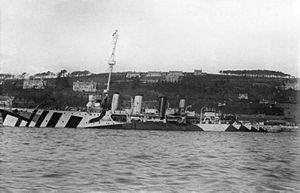Active-class cruiser

|
|
| Class overview | |
|---|---|
| Name: | Active |
| Builders: | Pembroke Royal Dockyard |
| Operators: |
|
| Preceded by: | Blonde class |
| Succeeded by: | None |
| Built: | 1910–13 |
| In commission: | 1911–20 |
| Completed: | 3 |
| Lost: | 1 |
| Scrapped: | 2 |
| General characteristics (as built) | |
| Type: | Scout cruiser |
| Displacement: | 3,340 long tons (3,390 t) (normal) |
| Length: | 405 ft (123.4 m) (o/a) |
| Beam: | 41 ft (12.5 m) |
| Draught: | 14 ft 6 in (4.4 m) |
| Installed power: |
|
| Propulsion: |
|
| Speed: | 25 knots (46 km/h; 29 mph) |
| Range: | 4,630 nautical miles (8,570 km; 5,330 mi) at 10 knots (19 km/h; 12 mph) |
| Complement: | 293 |
| Armament: |
|
| Armour: |
|
The Active-class cruisers were a trio of scout cruisers built for the Royal Navy shortly before the First World War. They were initially assigned to the First Fleet and became destroyer flotilla leaders in 1914. Amphion and Fearless and their flotillas were assigned to the Harwich Force when the war began in August 1914. They went out on a patrol on the first day of the war and Amphion and her destroyers encountered and sank a German minelayer. On the voyage home, the cruiser struck a mine laid by the German ship and sank. She was the first ship of the Royal Navy to be sunk in the war.
Fearless went out on the same patrol, but encountered nothing. She participated in the Battle of Heligoland Bight and the Cuxhaven Raid later that year. The ship and her destroyers were transferred to the Grand Fleet in early 1915. Active, on the other hand, remained with the Grand Fleet and both ships played minor roles in the Battle of Jutland the following year. After the battle, Fearless was converted into a submarine depot ship and rejoined the Grand Fleet in 1917 as the leader of a submarine flotilla. A year later, she accidentally rammed and sank one submarine as part of an incident that sardonically came to be known as the Battle of May Island.
Shortly after Jutland, Active again became a destroyer leader and escorted the main body of the Grand Fleet during the Action of 19 August 1916. By the end of the year, the ship was assigned to the Dover Patrol and was present during two battles with German destroyers, but was not engaged in either. She was transferred to the Mediterranean Fleet in 1918 and was based in Gibraltar for the rest of the war. The sister ships were both sold for scrap in 1920–21.
...
Wikipedia
